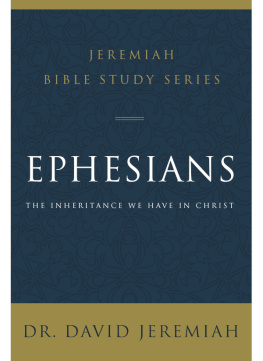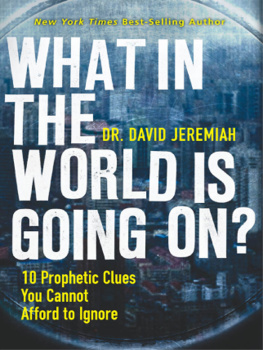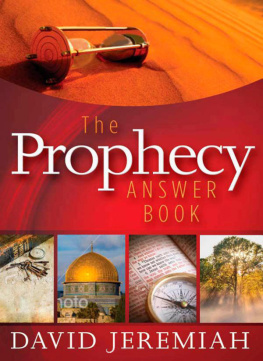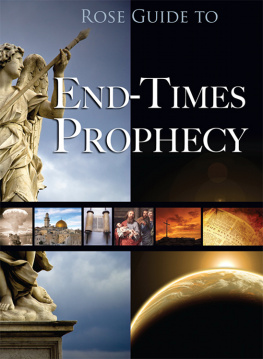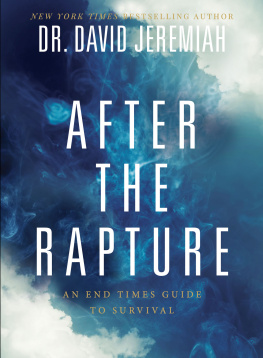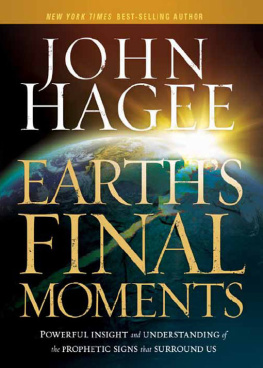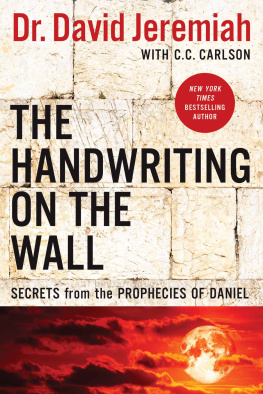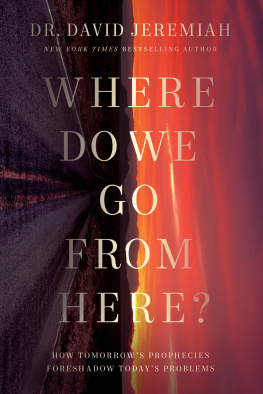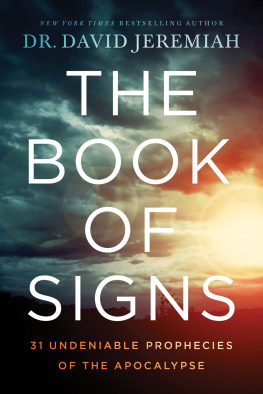Visit Tyndale online at www.tyndale.com.
TYNDALE and Tyndales quill logo are registered trademarks of Tyndale House Publishers, Inc.
Agents of the Apocalypse: A Riveting Look at the Key Players of the End Times
Copyright 2014 by David Jeremiah. All rights reserved.
Cover photograph of people copyright PeskyMonkey/iStockphoto. All rights reserved.
Cover photograph of galaxy copyright Igor Zh/Shutterstock. All rights reserved.
Designed by Jennifer Phelps
Published in association with Yates & Yates (www.yates2.com).
All Scripture quotations, unless otherwise indicated, are taken from the New King James Version. Copyright 1982 by Thomas Nelson, Inc. Used by permission. All rights reserved.
Scripture quotations marked KJV are taken from the Holy Bible, King James Version.
Scripture quotations marked NIV are taken from the Holy Bible, New International Version, NIV. Copyright 1973, 1978, 1984, 2011 by Biblica, Inc. Used by permission. All rights reserved worldwide.
Scripture quotations marked TLB are taken from The Living Bible, copyright 1971 by Tyndale House Foundation. Used by permission of Tyndale House Publishers, Inc., Carol Stream, Illinois 60188. All rights reserved.
Library of Congress Cataloging-in-Publication Data
Jeremiah, David, date.
Agents of the Apocalypse : a riveting look at the key players of the end times / Dr. David Jeremiah.
pages cm
Includes bibliographical references.
ISBN 978-1-4143-8049-0 (hc)
1. Bible. Revelation Criticism, interpretation, etc. I. Title.
BS2825.52.J46 2014
228'.06 dc23 2014024615
ISBN 978-1-4964-0045-1 (ePub); ISBN 978-1-4143-8475-7 (Kindle); ISBN 978-1-4964-0046-8 (Apple)
Build: 2014-09-12 10:30:40
Special Thanks
I would like to extend my deepest gratitude to Thomas Williams for his assistance in crafting the dramatization component of this book. I had the idea of bringing the characters of the Apocalypse to life to open up the Scriptures for you, the reader, but I could not have done that without his remarkable skills.
CONTENTS
INTRODUCTION
A GENTS OF THE A POCALYPSE came about because so many people urged me to write another book on Revelation. I can well understand the current interest in the end times. We live in an increasingly chaotic and godless world, and many Christians believe the dark shadows of the Apocalypse are looming on the horizon. In the last century we saw brutal persecution of Jews and faithful Christians in nations such as Germany, Russia, and China. Today Gods people continue to face torture and death in countries throughout the Middle East, Africa, and Asia. Even in Western nations, which have long upheld Christian principles, the repression of Christian expression and practice has begun. And if history is any guide, this discrimination against believers is bound to increase.
I encounter Christians every day who are anxious about the future, not only because of this increase in anti-Christian sentiment but also because of the decline of economic and social stability. In times like these, people tend to look even more closely at the book of Revelation, because perhaps above all others, it encourages Christians to keep hope alive. It recognizes the hard facts of worldwide disintegration and persecution, yet it assures Gods people of certain victory.
Because of the critical importance of Revelation and its relevance for our current reality, I recognize the need for fresh books to help keep its message alive. But that need also presents a big challenge. Revelation is hardly a fresh subject for authors to write about. No doubt thousands of books have been written on the topic, and I have already contributed several to that number myself. So when I was urged to write again on the subject, the burning question in my mind was, How can I write a book that will present this important message in a new and captivating way?
The answer that found its way into my mind was to use dramatized accounts to make the prophecies in Scripture come to life. But at first I could hardly accept the idea. I wanted to present the biblical truths of Revelation, not speculative fantasy that might lead readers to wonder about its accuracy. Yet the value of story as a vehicle for truth had been impressed on me by a man who is widely recognized as the most influential writer on Christianity in our time: C. S. Lewis.
Lewis was a young atheist when he first read Phantastes, a novel by the nineteenth-century Scottish Christian author George Macdonald. Lewis reported that a new quality, a bright shadow, leaped off its pages and that his imagination was, in a certain sense, baptized.
In response to those who were suspicious about the power of story to present truth, Lewis said, Reason is the natural organ of truth; but imagination is the organ of meaning. He was saying that stories can align reason with imagination and mind with emotion. When truth is put in imaginative form, it can be driven not only into the mind but also into the heart.
So I asked myself, Could stories be used to drive the message of Revelation into the human heart? The more I thought about it, the more convinced I became that they could. While the book of Revelation presents an overview of the future, it provides little detail. That is not its purpose. Yet the cataclysmic and triumphant events it portrays will affect real people in real situations. The players identified by Revelation in this end-times drama will also be real people either people who go bad and wreak destruction, such as the Antichrist and the false prophet, or faithful people such as the martyrs and the two witnesses, who stand against these demonic individuals.
Capturing these players through the lens of story allows Revelation to come to life in a new way. It enables us not only to see the overarching truths of Scripture but also to experience them vicariously. It gives us the chance to see the actions of these individuals up close and personal as they play out this cosmic drama.
In this book Ive devoted one chapter to each of the most prominent players in Revelation those who are the primary agents of the Apocalypse. After I did the research on the key players or groups of players, I asked my friend Tom Williams if he would write the dramatizations that illustrated the biblical truths. He agreed to do so, and we have ended up with this unique book.
I want to emphasize that in the writing of these fictional accounts, nothing presented in the Bible has been altered. The dramatized elements are constructed firmly on the facts of Revelation. The stories merely fill in the gaps that Revelation does not address. They present possibilities about how the biblical events could play out. I recognize fully that these scenes cannot fill in the gaps with perfect accuracy, but they offer one possibility among many with one goal in mind: to drive the truths of the end times not only into the mind but also into the heart. My hope is that these stories will serve as a reminder that the book of Revelation isnt just theoretical; its intended to depict real-life individuals and situations.
Each chapter in this book is divided into two sections. The first is the dramatized account, which is followed by a section called The Scripture behind the Story. My hope is that the dramatization will whet your appetite to explore the biblical truths behind the story. This second section digs deeper into Scripture, with discussions about what Revelation says and how it can be interpreted and applied. This setup enables you to separate the facts from the fiction and understand the biblical foundation that undergirds the story. Thus you get everything from this book that C. S. Lewis would want. The story drives the truth into your heart, and the Scripture behind the story drives it into your mind.


